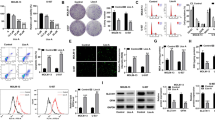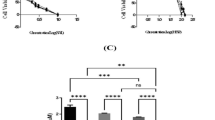Abstract
Cryptotanshinone is a biologically active compound from the root of Salvia miltiorrhiza. In the present study, we investigated the molecular mechanisms by which cryptotanshinone is in synergy with tumor necrosis factor-alpha (TNF-α) for the induction of apoptosis in human chronic myeloid leukemia (CML) KBM-5 cells. The co-treatment of cryptotanshinone with TNF-α reduced the viability of the cells [combination index (CI) < 1]. Concomitantly, the co-treatment of cryptotanshinone and TNF-α elicited apoptosis, manifested by enhanced the number of terminal deoxynucleotide transferase-mediated dUTP-nick-end labeling (TUNEL)-positive cells, the sub-G1 cell populations, and the activation of caspase-8 and -3, in comparison with the treatment with either drug alone. The treatment with cryptotanshinone further suppressed TNF-α-mediated expression of c-FLIPL, Bcl-xL, but the increased level of tBid (a caspase-8 substrate). Furthermore, cryptotanshinone activated p38 but not NF-κB in TNF-α-treated KBM-5 cells. The addition of a specific p38 MAPK inhibitor SB203580 significantly attenuated cryptotanshinone/TNF-α-induced apoptosis. The combination treatment of cryptotanshinone and TNF-α also stimulated the reactive oxygen species (ROS) generation. N-acetyl-l-cysteine (NAC, a ROS scavenger) was not only able to block cryptotanshinone/TNF-α-induced ROS production but also the activation of caspase-8 and p38 MAPK. Overall, our findings suggest that cryptotanshinone can sensitize TNF-α-induced apoptosis in human myeloid leukemia KBM-5 cells, which appears through ROS-dependent activation of caspase-8 and p38.







Similar content being viewed by others
Explore related subjects
Discover the latest articles and news from researchers in related subjects, suggested using machine learning.References
Chan KF, Siegel MR, Lenardo JM (2000) Signaling by the TNF receptor superfamily and T cell homeostasis. Immunity 13:419–422
Van Herreweghe F, Festjens N, Declercq W, Vandenabeele P (2010) Tumor necrosis factor-mediated cell death: to break or to burst, that’s the question. Cell Mol Life Sci 67:1567–1579
Rath PC, Aggarwal BB (1999) TNF-induced signaling in apoptosis. J Clin Immunol 19:350–364
Locksley RM, Killeen N, Lenardo MJ (2001) The TNF and TNF receptor superfamilies: integrating mammalian biology. Cell 104:487–501
Jiang Y, Woronicz JD, Liu W, Goeddel DV (1999) Prevention of constitutive TNF receptor 1 signaling by silencer of death domains. Science 283:543–546
Cho KH, Shin SY, Lee HW, Wolkenhauer O (2003) Investigations into the analysis and modeling of the TNF alpha-mediated NF-kappa B-signaling pathway. Genome Res 13:2413–2422
Vietor I, Schwenger P, Li W, Schlessinger J, Vilcek J (1993) Tumor necrosis factor-induced activation and increased tyrosine phosphorylation of mitogen-activated protein (MAP) kinase in human fibroblasts. J Biol Chem 268:18994–18999
Antosiewicz J, Ziolkowski W, Kaczor JJ, Herman-Antosiewicz A (2007) Tumor necrosis factor-alpha-induced reactive oxygen species formation is mediated by JNK1-dependent ferritin degradation and elevation of labile iron pool. Free Radic Biol Med 43:265–270
Izeradjene K, Douglas L, Tillman DM, Delaney AB, Houghton JA (2005) Reactive oxygen species regulate caspase activation in tumor necrosis factor-related apoptosis-inducing ligand-resistant human colon carcinoma cell lines. Cancer Res 65:7436–7445
Woo CH, Eom YW, Yoo MH et al (2000) Tumor necrosis factor-alpha generates reactive oxygen species via a cytosolic phospholipase A2-linked cascade. J Biol Chem 275:32357–32362
Wang Z, Kishimoto H, Bhat-Nakshatri P, Crean C, Nakshatri H (2005) TNFalpha resistance in MCF-7 breast cancer cells is associated with altered subcellular localization of p21CIP1 and p27KIP1. Cell Death Differ 12:98–100
Tomek S, Horak P, Pribill I et al (2004) Resistance to TRAIL-induced apoptosis in ovarian cancer cell lines is overcome by co-treatment with cytotoxic drugs. Gynecol Oncol 94:107–114
Khwaja A, Tatton L (1999) Resistance to the cytotoxic effects of tumor necrosis factor alpha can be overcome by inhibition of a FADD/caspase-dependent signaling pathway. J Biol Chem 274:36817–36823
Kim H, Kim EH, Eom YW et al (2006) Sulforaphane sensitizes tumor necrosis factor-related apoptosis-inducing ligand (TRAIL)-resistant hepatoma cells to TRAIL-induced apoptosis through reactive oxygen species-mediated up-regulation of DR5. Cancer Res 66:1740–1750
Moon DO, Kim MO, Lee JD, Choi YH, Kim GY (2010) Rosmarinic acid sensitizes cell death through suppression of TNF-alpha-induced NF-kappaB activation and ROS generation in human leukemia U937 cells. Cancer Lett 288:183–191
Ahn KS, Sethi G, Aggarwal BB (2007) Simvastatin potentiates TNF-alpha-induced apoptosis through the down-regulation of NF-kappaB-dependent antiapoptotic gene products: role of IkappaBalpha kinase and TGF-beta-activated kinase-1. J Immunol 178:2507–2516
Kim EJ, Jung SN, Son KH et al (2007) Antidiabetes and antiobesity effect of cryptotanshinone via activation of AMP-activated protein kinase. Mol Pharmacol 72:62–72
Chen W, Luo Y, Liu L et al (2010) Cryptotanshinone inhibits cancer cell proliferation by suppressing mammalian target of rapamycin-mediated cyclin D1 expression and Rb phosphorylation. Cancer Prev Res (Phila Pa) 3:1015–1025
Park IJ, Kim MJ, Park OJ et al (2010) Cryptotanshinone sensitizes DU145 prostate cancer cells to Fas(APO1/CD95)-mediated apoptosis through Bcl-2 and MAPK regulation. Cancer Lett 298(1):88–98
Shin DS, Kim HN, Shin KD et al (2009) Cryptotanshinone inhibits constitutive signal transducer and activator of transcription 3 function through blocking the dimerization in DU145 prostate cancer cells. Cancer Res 69:193–202
Hur JM, Shim JS, Jung HJ, Kwon HJ (2005) Cryptotanshinone but not tanshinone IIA inhibits angiogenesisin vitro. Exp Mol Med 37:133–137
Chou TC (2010) Drug combination studies and their synergy quantification using the Chou-Talalay method. Cancer Res 70:440–446
Tracey KJ, Cerami A (1993) Tumor necrosis factor: an updated review of its biology. Crit Care Med 21:S415–422
Fulda S (2010) Evasion of apoptosis as a cellular stress response in cancer. Int J Cell Biol 2010:370835
Garg AK, Aggarwal BB (2002) Reactive oxygen intermediates in TNF signaling. Mol Immunol 39:509–517
Li X, Moody MR, Engel D et al (2000) Cardiac-specific overexpression of tumor necrosis factor-alpha causes oxidative stress and contractile dysfunction in mouse diaphragm. Circulation 102:1690–1696
Bazzoni F, Beutler B (1996) The tumor necrosis factor ligand and receptor families. N Engl J Med 334:1717–1725
Chen B, Cao S, Zhang Y et al (2009) A novel peptide (GX1) homing to gastric cancer vasculature inhibits angiogenesis and cooperates with TNF alpha in anti-tumor therapy. BMC Cell Biol 10:63
Watanabe N, Niitsu Y, Sone H et al (1986) Therapeutic effect of endogenous tumor necrosis factor on ascites Meth A sarcoma. J Immunopharmacol 8:271–283
Chen W, Luo Y, Liu L et al (2010) Cryptotanshinone inhibits cancer cell proliferation by suppressing Mammalian target of rapamycin-mediated cyclin D1 expression and Rb phosphorylation. Cancer Prev Res (Phila) 3:1015–1025
Ye Y, Xu W, Zhong W (2010) Effects of cryptotanshinone on proliferation and apoptosis of Hela cell line of cervical cancer. Zhongguo Zhong Yao Za Zhi 35:118–121
Park IJ, Kim MJ, Park OJ et al (2010) Cryptotanshinone sensitizes DU145 prostate cancer cells to Fas(APO1/CD95)-mediated apoptosis through Bcl-2 and MAPK regulation. Cancer Lett 298:88–98
Aggarwal BB (2004) Nuclear factor-kappaB: the enemy within. Cancer Cell 6:203–208
Amran D, Sanchez Y, Fernandez C et al (2007) Arsenic trioxide sensitizes promonocytic leukemia cells to TNFalpha-induced apoptosis via p38-MAPK-regulated activation of both receptor-mediated and mitochondrial pathways. Biochim Biophys Acta 1773:1653–1663
Bajbouj K, Poehlmann A, Kuester D et al (2009) Identification of phosphorylated p38 as a novel DAPK-interacting partner during TNFalpha-induced apoptosis in colorectal tumor cells. Am J Pathol 175:557–570
Lo YY, Cruz TF (1995) Involvement of reactive oxygen species in cytokine and growth factor induction of c-fos expression in chondrocytes. J Biol Chem 270:11727–11730
Dolado I, Swat A, Ajenjo N, De Vita G, Cuadrado A, Nebreda AR (2007) p38alpha MAP kinase as a sensor of reactive oxygen species in tumorigenesis. Cancer Cell 11:191–205
Acknowledgments
The present study was supported by the Korea Science and Engineering Foundation (KOSEF) grant funded by the Korea government (MEST) (No. 2011-0063466). We thank to Dr. Aggarwal (The University of Texas M.D. Anderson Cancer Center) for providing KBM-5 cell line.
Author information
Authors and Affiliations
Corresponding author
Additional information
Ji-Hyun Kim, Soo-Jin Jeong contributed equally to this work.
Rights and permissions
About this article
Cite this article
Kim, JH., Jeong, SJ., Kwon, TR. et al. Cryptotanshinone enhances TNF-α-induced apoptosis in chronic myeloid leukemia KBM-5 cells. Apoptosis 16, 696–707 (2011). https://doi.org/10.1007/s10495-011-0605-1
Published:
Issue Date:
DOI: https://doi.org/10.1007/s10495-011-0605-1




